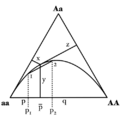Hardy–Weinberg law facts for kids
The Hardy–Weinberg law was developed independently by an English mathematician, G.H. Hardy, and a German doctor, Wilhelm Weinberg. This concept is also known as the Hardy–Weinberg equilibrium, Hardy–Weinberg theorem or Hardy–Weinberg principle. Sometimes Weinberg's name is placed first.
The law is a foundation of population genetics, and it is still taught to students today. It states that the proportions of alleles of all genes in any population will remain the same unless perturbed (disturbed). That applies to all loci on all chromosomes in the population. Possible perturbations are:
- ♦ gene mutation
- ♦ natural selection
- ♦ small population size where random effects like genetic drift and inbreeding may occur. H/W populations are assumed to be infinite in size.
- ♦ assortative mating instead of random mating. In effect, this would split the population down into small groups, see item above.
- ♦ migration into or out of the population under study.
It follows that any systematic change in the frequency of alleles in a population must be due to the effect of one or more of these causes. Of course, like all aspects of Mendelian inheritance, the expected proportions of alleles are probabilities. It was for that reason that statistical tests of significance, such as standard errors, were developed.
Although all changes must be due to perturbations, not all perturbations lead to changes. The classic case is balancing selection, such as heterozygote advantage: "Heterosis: the heterozygote at a locus is fitter than either homozygote". Balancing selection leads to an equilibrium population with Hardy–Weinberg proportions
Generalisation
The law permits the prediction of genotype frequencies from a knowledge of gene frequencies.
- If alleles A and a are in the proportions p and q, the three zygotic types AA, Aa, and aa are in the proportions p2: 2pq: q2.
Thus, equations can be written in terms of allele frequencies, and hypotheses about how phenotypes are inherited can be tested from population data.
Images for kids
See also
 In Spanish: Ley de Hardy-Weinberg para niños
In Spanish: Ley de Hardy-Weinberg para niños


